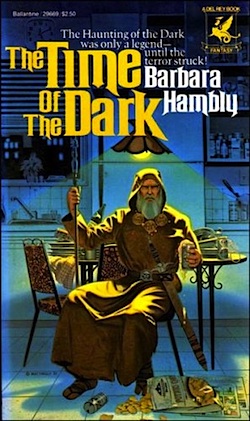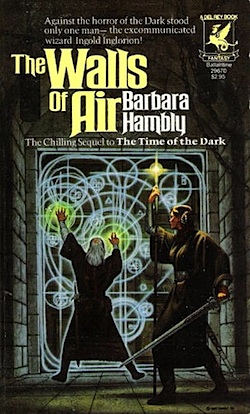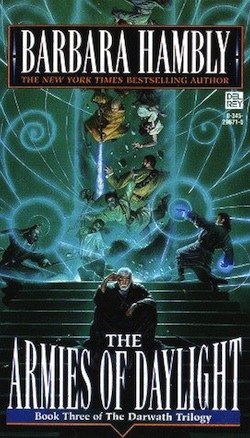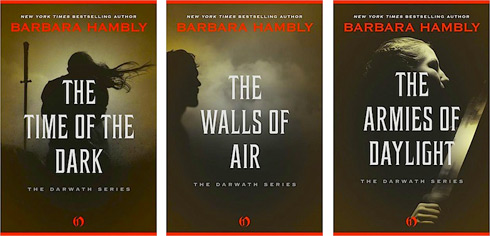This year has seen the release of much of Barbara Hambly’s out-of-print backlist in ebook format from Open Road Media. An exciting development for me: I’m young enough that some of these books were hard to find before I was even able to properly read. Yet, as an SFF reader, I’d heard nothing but praise for Hambly’s work since I became aware it existed, and her in-print historical mysteries made a convincing argument that I would really enjoy her fantasy—if only I could find it.
So you can imagine how welcome I found the news that Hambly had released ebook versions of the likes of Dragonsbane and The Ladies of Mandrigyn, amongst the greater part of her previously hard-to-find oeuvre. So welcome, in fact, that I simply have to tell you all about it.
I’m going to proceed in the general order of original publication. That means kicking off today with The Time of the Dark (1982) and its two sequels, The Walls of Air (1983) and The Armies of Daylight (1983), the three original books of Hambly’s Darwath series. Look out for future posts on The Silent Tower and the Sunwolf and Starhawk series—and perhaps more!
1982. I didn’t exist yet. Margaret Thatcher had been Britain’s Prime Minister for going on three years, the USSR was still a world power, and Ronald Reagan was President of the USA. (In case you’re wondering, I had to look that last one up.) Downbelow Station won the Hugo, Star Trek II: The Wrath of Khan showed in cinemas, and Del Rey sent The Time of the Dark out into the world for the very first time.

It’s a strong and atmospheric debut. In her dreams, graduate student Gil Patterson witnesses terror and panic in the night-time cities of another world. When the wizard Ingold Inglorion crosses the void between worlds to follow her home, it becomes clear her nightmares are not dreams at all. Ingold’s home is menaced by the Dark, beings all but forgotten until they returned in a welter of slaughter: the only hope for the Kingdom of Renwath lies in the ancestral memories of the House of Dare, whose last surviving member, Prince Tir, is a child too young to speak. Seeking refuge for this child, Ingold comes to Gil.
Things don’t go smoothly, and before long Gil and Ingold—joined by auto-mechanic Rudy Solis—are back in Ingold’s world, fighting against the extinction of the remnants of the realm. In the course of a long, grim flight to the last place of safety, the impenetrable Keep of Dare, Rudy becomes emotionally involved with the young widowed queen, Gil becomes a warrior, and all three are integrally involved in the politics of survival.
Hambly’s characteristic precision of phrase and turn of description is present here, even so early in her career. From the very beginning, the atmosphere is full of tension and dread. The tone belongs almost to horror: not the loud, garish horror of slasher films or serial killer thrillers, but the quiet, creeping, pervasive terror of a cold-sweat nightmare. The creatures of the Dark are both inimical and incomprehensible, and it’s their utter alienness—as well as their relentless progress—that renders them disturbing. (And I’m not ashamed to admit I got up to turn all the lights on while I was reading.) The fact that there can be no negotiation or compromise—not even communication—with the Dark makes them more like a natural catastrophe than antagonists. “What can I say of the Dark, Gil?” Ingold says:
“What can I say that you don’t know already? That they are the sharks of night? That they pull the flesh from the bones, or the blood from the flesh, or the soul and spirit from the living body and let it stumble mindlessly to an eventual death from starvation? That they ride the air in darkness, hunt in darkness, and that fire or light or even a good bright moon will keep them away? Would that tell you what they are?”
More human antagonisms play out against the backdrop of the catastrophe of the Dark, of course. Everyone in the Kingdom of Renwath wants to survive, but Lord Alwir, the queen’s brother, and the Church Bishop Govannin differ from Ingold Inglorion in their opinions both of the severity of the threat, and in how best survival is to be achieved. The politics and conflicts of personality established here continue in the next two instalments, in which the Church’s disapproval of things magical will come to play a greater role.
The Time of the Dark is part apocalypse story, and part — to borrow the coinage of, I believe, Jo Walton — portal fantasy. I’m a little surprised by how much more popular portal fantasy seems to have been in the eighties than it is today: it might merely be confirmation bias at work, but I can think of at least three other eighties-vintage portal fantasies (including Guy Gavriel Kay’s Fionavar Tapestry), while I’m hard-pressed to name more than one from the last five years. In the case of the Darwath series, the juxtaposition of worlds and worldviews works very well. Gil and Rudy have unique perspectives on the Kingdom of Renwath and the Rising of the Dark, and in The Walls of Air and The Armies of Daylight these come even more to the fore.

The Walls of Air, now that I’ve read it a second time, strikes me strongly as a book about learning, and about apprenticeship. The survivors of The Time of the Dark‘s desperate flight are holed up in the Keep of Dare. Outside, at night, the Dark wait. Inside, politics and claustrophobia form their own toxic atmosphere. Food is short. Refugees are arriving at the gates. In an attempt to find other wizards to help against the Dark, Ingold takes Rudy on a dangerous cross-country journey to the citadel of Quo, home of wizardry and learning. In the Keep, Gil and Queen Minalde must navigate the politics of subsistence and Lord Alwir’s determination to form an alliance with the armies of the southern power of Alketch in order to invade the Dark’s underground nests.
The journey to Quo is also Rudy’s journey of introduction into the disciplines of wizardry. Hambly’s wizardry is very much a combination of vocation and talent: the desire to know for the sake of knowledge, a fascinating combination of a perpetual scientific curiosity and vast—if occasionally odd—understanding. This sense of vocation is common to wizards across all Hambly’s early work. One might almost say it’s their defining attribute, and I’ll have more to say about it when I come to talk about the Silent Tower series.
In The Walls of Air, under Ingold’s unbending tutelage, Rudy grows into his identity as a wizard. He grows, too, in his understanding of the world he’s adopted as his own. In the wake of a terrible confrontation at Quo, a Rudy both more confident and more aware of his own limits emerges.
One of the most interesting things about The Walls of Air is how both Rudy’s and Gil’s previous lives inform their relationships to the new world in which they find themselves. Their experiences change them, but Gil is still a student of history, and the information she painstakingly collects from the few records which exist of the last time the Dark rose adds to the story’s tension as Ingold and Rudy approach Quo.

The Armies of Daylight provides the conclusion to the trilogy. Alwir will have his way: the Keep of Dare and its allies will mount an invasion of the Nests of the Dark. But how successfully? For Gil’s analysis of history suggests that perhaps, the last time they rose, no human agency caused the Dark to eventually retreat again. Meanwhile, tensions continue to rise between Alwir and Bishop Govannin on the one hand, and Ingold, Rudy, and the wizards on the other, with Queen Minalde caught in the middle.
In terms of personal politics and what actually happens, it’s probably the most complex story of the three: there are betrayals and reversals and some really unexpected developments, including the return of a character long believed dead. The tense atmosphere of cold, tense, creeping dread lasts right up until the final confrontation.
Which I’m not going to spoiler, because if you haven’t read the books and you intend to, knowing what happens with regard to the Dark in advance might wreck the fun. It would’ve ruined it for me.
The three books together form a very well-constructed trilogy. I’m particularly impressed by the way in which The Walls of Air fails to suffer from Middle Book Syndrome: it’s as tense and nerve-wracking as the first and final volumes. These are damn good books. Why did they ever go out of print in the first place?
A final note on the ebooks themselves: They’re generally well-laid out, but a small number of typos caught my eye, and — I don’t know whether this was also true for original paper format—there are no section breaks within chapters, even at moments such as changes in point of view where one might expect them.
P.S.: The thought occurred to me, after I wrote this review, that one could read a homily on the perils of climate change denialism into The Armies of Daylight. Or maybe I’m just strange that way?
Liz Bourke needs a more exciting bio. When she finds one, she’ll let you know.










